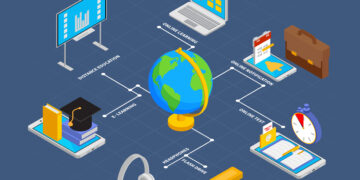The world of education is evolving faster than ever, thanks to technological advances. Among these, the Internet of Things (IoT) stands out, revolutionizing how we learn, teach, and manage educational institutions. Imagine walking into a classroom where your desk recognizes you, the lights adjust to your preferences, and lessons are tailored to your learning pace. That’s the magic of IoT in education—it’s not just a futuristic dream; it’s happening right now.
1. Introduction to IoT in Education
IoT in education connects devices, tools, and systems to improve learning experiences and operational efficiency. From classrooms to entire campuses, IoT enables seamless communication between devices, making learning environments smarter and more intuitive.
2. How IoT is Revolutionizing Classrooms
Picture this: you step into a classroom where attendance is marked automatically, lesson plans are displayed on a smartboard, and the air conditioner adjusts itself based on the room’s temperature. IoT makes this a reality. By integrating smart devices into classrooms, educators can focus more on teaching while technology handles mundane tasks.
3. What Are Smartboards and Their Benefits?
Smartboards are interactive digital boards that replace traditional chalkboards. They allow teachers to use multimedia, engage students through visuals, and make learning interactive. With IoT connectivity, smartboards can share data with other devices, enabling collaborative learning.
4. Personalized Learning Through IoT
No two students learn the same way. IoT recognizes this and provides personalized education through smart tools. For instance, wearable devices can track a student’s progress and suggest resources tailored to their needs. Imagine a virtual tutor available 24/7, helping students at their own pace.
Reference Blog: IoT in Education: From Smart Classrooms to Connected Campuses
5. The Rise of Smart Campuses
IoT extends beyond classrooms, transforming entire campuses into intelligent ecosystems. These campuses use IoT to manage energy, track assets, and provide a safe environment. From automated lighting systems to real-time alerts for maintenance, IoT ensures campuses run smoothly and efficiently.
6. IoT and Enhanced Security in Schools
Safety is a top priority in educational institutions, and IoT plays a vital role in enhancing it. Smart surveillance cameras, biometric access controls, and real-time alerts make schools safer. Parents can even monitor their child’s school activities through connected apps.
7. Streamlining Administrative Tasks
IoT automates time-consuming administrative tasks like attendance tracking, resource management, and scheduling. With RFID tags, students can check out library books or access labs without human intervention, saving time and reducing errors.
8. Challenges of Implementing IoT in Education
Despite its benefits, IoT adoption comes with challenges. High installation costs, data privacy concerns, and the need for technical expertise can hinder implementation. Institutions must balance innovation with security and cost-efficiency.
9. Future Trends of IoT in Education
The future of IoT in education looks promising. From AI-driven learning platforms to immersive AR/VR experiences, IoT will continue to reshape education. We may soon see schools where robots assist teachers and VR replaces traditional field trips.
Also Read: https://insidethenation.com/cross-platform-mobile-app-development-elevate-your-business-potential/
10. Conclusion: A Smarter Tomorrow
IoT is not just a buzzword; it’s the foundation for smarter education. As we embrace this technology, we move closer to a world where learning is more accessible, engaging, and efficient. From smartboards to smart campuses, IoT is paving the way for a brighter future.
11. FAQs About IoT in Education
1. What is IoT in education?
IoT in education refers to the use of connected devices and systems to enhance learning experiences and manage educational institutions more efficiently.
2. How do smartboards improve learning?
Smartboards make lessons interactive and engaging by integrating visuals, multimedia, and real-time collaboration.
3. Are there any risks with IoT in education?
Yes, data privacy and high implementation costs are major concerns. However, with proper measures, these risks can be mitigated.
4. What are smart campuses?
Smart campuses use IoT technologies to optimize resources, improve safety, and create efficient learning environments.
Casey Morgan is a Digital Marketing Manager with over 10 years of experience in developing and executing effective marketing strategies, managing online campaigns, and driving brand growth. she has successfully led marketing teams, implemented innovative digital solutions, and enhanced customer engagement across various platforms.













































